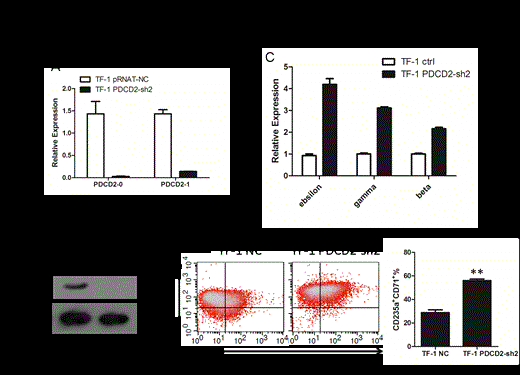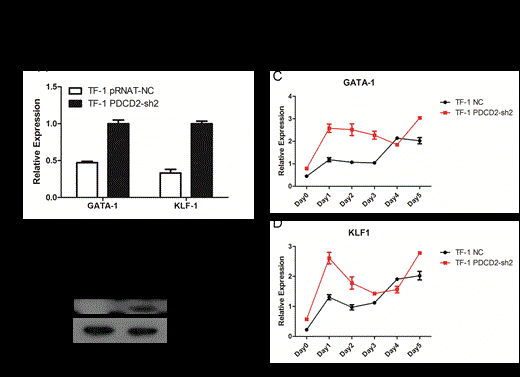Abstract
PDCD2 was first identified in human in 1995, which is highly homologous to a rat programmed cell death related gene Rp8. Nonetheless, up to now, there have been only 43 papers about PDCD2 published. Therefore, the role of PDCD2 in erythroid differentiation remains largely unknown.
TF-1 cell is a erythroleukemia erythroblast, which is a good system for investigating the proliferation and differentiation of myeloid progenitor cells for its responsiveness to multiple cytokines.To study the function of PDCD2 in erythroid differentiation, we performed PDCD2 knockdown in TF-1 cells. The expression of PDCD2 was significantly decreased at both mRNA and protein level (Fig.1A, B). The expression of globin genes were detected by real-time qPCR, and the results indicated that ebsilon-, gamma-, beta-globin genes expression increased after PDCD2 knockdown in TF-1 cells (Fig.1C). Also, the expression of CD71 and CD235a at cell surface was measured by FACS, and our data showed that the percentage of CD71+CD235a+ cells was significantly increased by PDCD2 knockdown in TF-1 cells (Fig.1D).
Furthermore, we induced TF-1 cells to erythroid differentiation by removing GM-CSF and adding EPO in culture medium. Both globin genes expression at mRNA level and CD71+CD235a+ expression at cell surface were measured at different time points during induction. With the progression of induction, expression of globin genes and the percentage of CD71+CD235a+ cells were increased in both control and PDCD2 knockdown cells (Fig.2). However, at same time points, increased expression of globin genes were detected in PDCD2 knockdown cells, compared to control cells (Fig.2A, B). Similar pattern was also observed in terms of the expression of CD71+CD235a+ at cell surface (Fig.2C).
GATA-1 and KLF1 are the two most important transcription factors during erythroid differentiation. We detected the expression of the two TFs after PDCD2 knockdown in TF-1 cells. We found that expression of GATA-1 and KLF1 was augmented after PDCD2 knockdown (Fig.3A, B), and the augmentation remained during the induced differentiation (Fig.3C, D).
To get a further insight of how PDCD2 regulates erythrioid differentiation, we performed a PDCD2 ChIP assay in normal TF-1 cells. Our data showed that there was an enrichment of PDCD2 at GATA-1 promoter region (data not shown). Since there is no evidence indicating that PDCD2 is a transcription factor, we assumed that PDCD2 bind at DNA sequence indirectly through interacting with other proteins. We thus performed co-IP assay of HDAC8 and HDAC1 in TF-1 cells and found that PDCD2 interacted with HDAC8 (data not shown).
These data indicate that PDCD2 knockdown promoted induced erythroid differentiation in TF-1 cells. The promotion may be partially explained by increased expression of GATA-1 and KLF1. PDCD2 interacting with HDAC8 and binding at GATA-1 promoter region may play a role during erythroid differentiation.
No relevant conflicts of interest to declare.
Author notes
Asterisk with author names denotes non-ASH members.




This feature is available to Subscribers Only
Sign In or Create an Account Close Modal